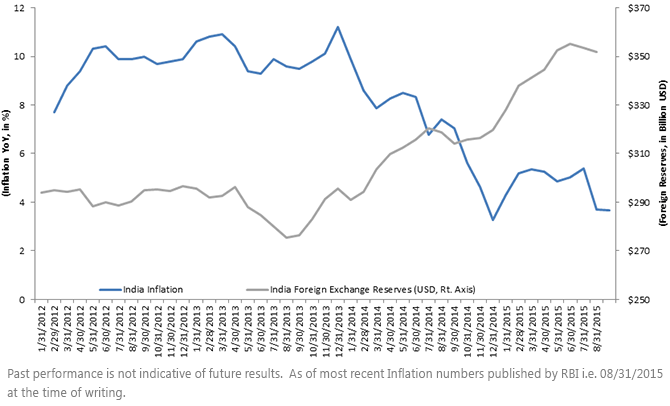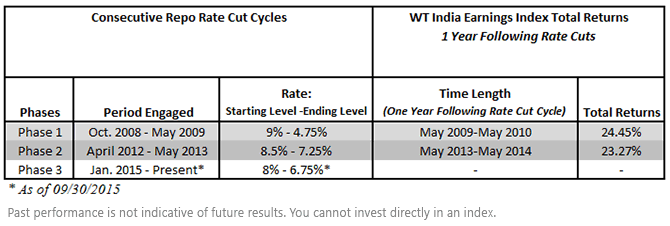India’s Fourth Consecutive Rate Cut and Its Implications


 What Does Rate Cut Mean for the Economy and Investors?
Let’s look at the immediate impact of the rate cut first.
Financials are a key sector in India, accounting for about 6% of its $2.5 trillion economy, with commercial banking underpinning growth in this sector.4 Within hours of RBI cutting rates, India’s largest bank, the State Bank of India (SBI), was first to trim down its lending rates, bringing them down by 40 bps. ICICI bank, India’s largest private sector bank, followed suit by cutting its lending rates by 35 bps. It’s important to note that SBI and ICICI are regional behemoths, and combined they have assets close to $500 billion, or about 26% of market share in deposits and loans.5 All other regional giants, such as Axis Bank, Punjab National Bank and Bank of Baroda6, have also slashed their lending rates by ~40 bps. Reduction in borrowing rates is a major boost for lending activity and thus translates to all other sectors. Real estate, construction, manufacturing, automobiles, etc., are the primary beneficiaries of less expensive credit, as are Financials, which could experience significant expansion of the earnings base.
In short, RBI’s rate reduction could be analogous to the electric current that jump-starts a car in the cold of winter. As a result, we would expect a pickup in the velocity of money and continued acceleration of the Indian economy, which has already been gaining momentum, owing to macro factors that we have previously discussed.
Now, let’s look at a medium-term impact of the rate cut.
As economic activity continues to gain momentum, we expect to see an increase in private sector earnings with some lag. It’s important to highlight here that the WisdomTree India Earnings Index weights companies traded in India based on their trailing earnings. Thus, over a medium term, as equities go up, supported by improving corporate earnings, we believe the WisdomTree India Earnings Index could represent a smart exposure to the Indian market. The table below shows periods in which RBI engaged in consecutive rate-cut cycles and reaction of the WisdomTree India Earnings Index in the following year.
What Does Rate Cut Mean for the Economy and Investors?
Let’s look at the immediate impact of the rate cut first.
Financials are a key sector in India, accounting for about 6% of its $2.5 trillion economy, with commercial banking underpinning growth in this sector.4 Within hours of RBI cutting rates, India’s largest bank, the State Bank of India (SBI), was first to trim down its lending rates, bringing them down by 40 bps. ICICI bank, India’s largest private sector bank, followed suit by cutting its lending rates by 35 bps. It’s important to note that SBI and ICICI are regional behemoths, and combined they have assets close to $500 billion, or about 26% of market share in deposits and loans.5 All other regional giants, such as Axis Bank, Punjab National Bank and Bank of Baroda6, have also slashed their lending rates by ~40 bps. Reduction in borrowing rates is a major boost for lending activity and thus translates to all other sectors. Real estate, construction, manufacturing, automobiles, etc., are the primary beneficiaries of less expensive credit, as are Financials, which could experience significant expansion of the earnings base.
In short, RBI’s rate reduction could be analogous to the electric current that jump-starts a car in the cold of winter. As a result, we would expect a pickup in the velocity of money and continued acceleration of the Indian economy, which has already been gaining momentum, owing to macro factors that we have previously discussed.
Now, let’s look at a medium-term impact of the rate cut.
As economic activity continues to gain momentum, we expect to see an increase in private sector earnings with some lag. It’s important to highlight here that the WisdomTree India Earnings Index weights companies traded in India based on their trailing earnings. Thus, over a medium term, as equities go up, supported by improving corporate earnings, we believe the WisdomTree India Earnings Index could represent a smart exposure to the Indian market. The table below shows periods in which RBI engaged in consecutive rate-cut cycles and reaction of the WisdomTree India Earnings Index in the following year.
 In both of the previous phases (1 & 2), the Index reacted with double-digit returns one year after the end of the rate-cut cycle. We believe this is the medium-term impact that investors should be mindful of.
Overall, rate cuts typically support equities over the medium term; however, there is also a plethora of other macro parameters that we have been covering in previous blog posts that could make India attractive. We do expect Indian equities to go through phases of temporarily heightened volatility driven by global or local factors. However, Indian equities with an element of an earnings-weighted approach look attractive at current levels.
1RBI’s description implies that the bulk of the reduction is being done proactively based on forward-looking inflation estimates.
2Source: Reserve Bank of India, as of 8/31/15.
3Source: Bloomberg, as of 8/31/15.
4Source: Government of India, Indian Brand Equity Foundation, as of 8/31/15.
5Source: Government of India, Indian Brand Equity Foundation, as of 8/31/15.
6Axis Bank and Bank of Baroda are a part of the WisdomTree India Earnings Index.
In both of the previous phases (1 & 2), the Index reacted with double-digit returns one year after the end of the rate-cut cycle. We believe this is the medium-term impact that investors should be mindful of.
Overall, rate cuts typically support equities over the medium term; however, there is also a plethora of other macro parameters that we have been covering in previous blog posts that could make India attractive. We do expect Indian equities to go through phases of temporarily heightened volatility driven by global or local factors. However, Indian equities with an element of an earnings-weighted approach look attractive at current levels.
1RBI’s description implies that the bulk of the reduction is being done proactively based on forward-looking inflation estimates.
2Source: Reserve Bank of India, as of 8/31/15.
3Source: Bloomberg, as of 8/31/15.
4Source: Government of India, Indian Brand Equity Foundation, as of 8/31/15.
5Source: Government of India, Indian Brand Equity Foundation, as of 8/31/15.
6Axis Bank and Bank of Baroda are a part of the WisdomTree India Earnings Index.
Important Risks Related to this Article
Investments in emerging, offshore or frontier markets are generally less liquid and less efficient than investments in developed markets and are subject to additional risks, such as risks of adverse governmental regulation and intervention or political developments.
Investments focused in India increase the impact of events and developments associated with the region, which can adversely affect performance.
Please keep in mind that high double-digit returns were achieved primarily during favorable market conditions. Investors should not expect that such favorable returns can be consistently achieved.


